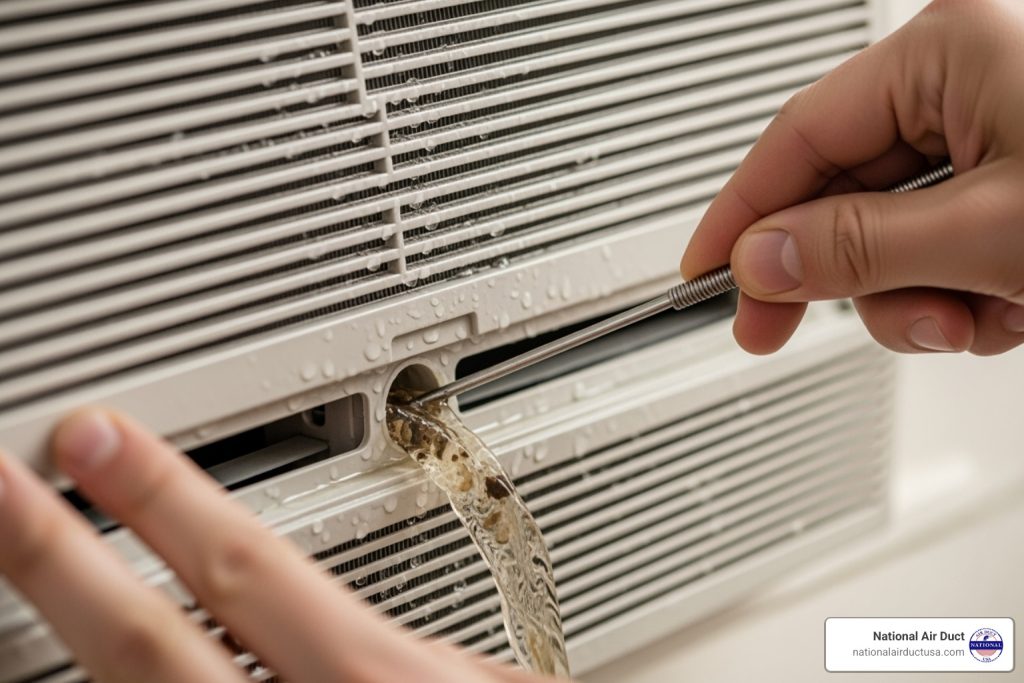Why Window AC Drain Line Cleaning Is Essential for Your Home
If you need to know how to clean window ac drain line, here’s the quick answer:
- Turn off and unplug your AC unit
- Locate the drain hole underneath the exterior part of the unit
- Clear debris using a bottle brush or thin wire
- Flush with vinegar – pour 1 cup of distilled white vinegar down the line
- Use a wet/dry vacuum to suction out remaining clogs
- Clean the drain pan and reassemble the unit
Window air conditioners remove a lot of moisture from the air in your New York home. This water needs to drain properly, or you risk water damage, mold growth, and higher energy bills.
Over time, your AC’s drain line can clog with dust, algae, and debris. This causes water to back up into the drain pan, which can overflow into your home and create a breeding ground for mold.
Many homeowners only notice a problem when they see water on the windowsill or smell a musty odor. Fortunately, cleaning the drain line is a quick DIY task that prevents costly repairs and health issues.
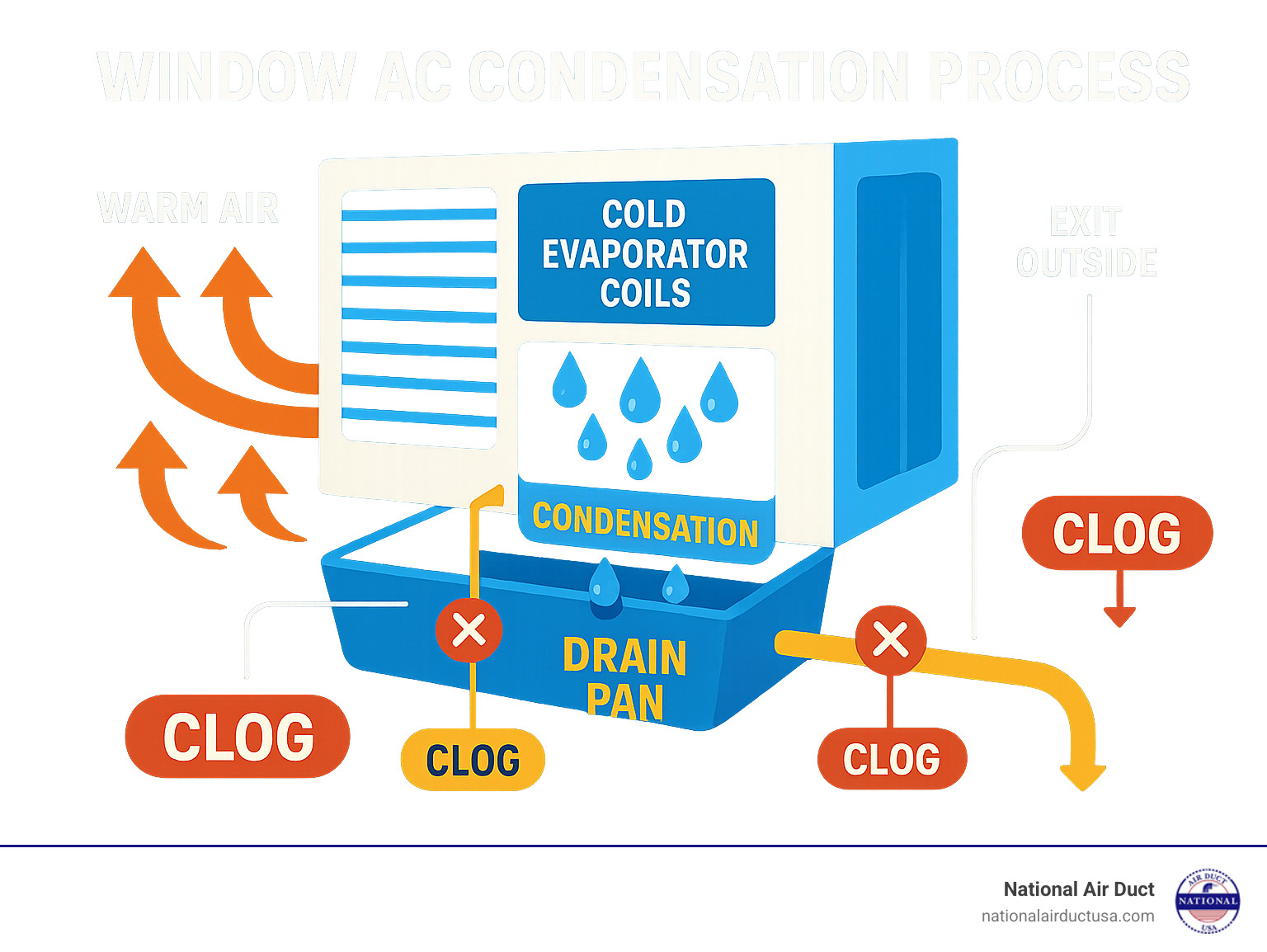
Why Your Window AC Drain Line Clogs and Why It Matters
Your window AC removes gallons of water from the air via condensation removal. This water should flow through the drain line and exit outside. When the drain line clogs, water backs up into the unit and can leak into your home.
Water damage is the most immediate concern. An overflowing drain pan can damage walls, floors, and ceilings, leading to expensive repairs.
Stagnant water also harms indoor air quality. It’s a breeding ground for algae and mold growth, which release spores into your home. These can trigger allergies, asthma, and other respiratory issues. The risks of indoor mold are significant.
Your energy efficiency also suffers. A backed-up system works harder, increasing electricity bills and wear on the unit.
The primary cause of clogs is dust mixing with moisture in the drain pan, creating the perfect environment for algae and mold growth. Worse, clogged lines can become mosquito breeding grounds, and standing water can cause rust, shortening your unit’s lifespan.
Learning how to clean window ac drain line systems is straightforward and prevents these issues, keeping your home comfortable and healthy.
Spotting the Problem: Signs of a Clogged Drain Line
Your AC unit will usually show warning signs before a clog becomes a major problem. Recognizing these signals can save you from water damage and expensive repairs.
Water pooling or dripping indoors is the most alarming sign. Water on the windowsill, wall, or floor near the unit indicates a blocked drain line and an overflowing drain pan.
Check for a full drain pan. Standing water in the pan is a clear warning sign that an overflow is imminent.
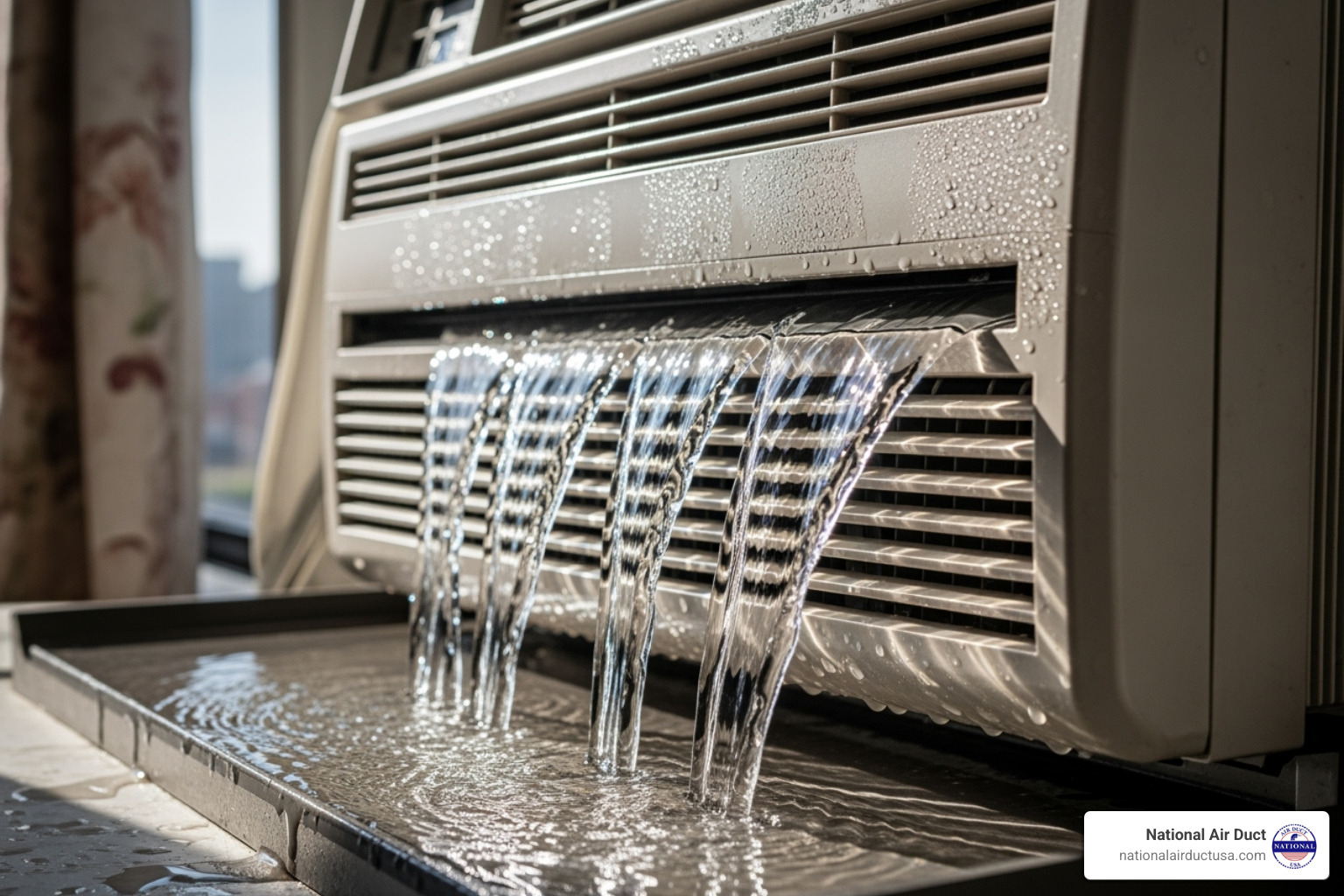
A musty or moldy smell from your AC is another key indicator. Stagnant water in the drain pan allows mold and mildew to grow, and the spores are circulated into your room.
You may also notice reduced cooling. A unit struggling with backed-up water works harder and less effectively. If your AC runs constantly but doesn’t cool the room, a clog could be the cause.
Many modern units have a float switch that automatically shuts the unit off when the drain pan is too full. This prevents water damage but can leave you with a hot room and a non-working AC.
If you can see the drain pan, look for visible algae or slimy growth. This is a clear sign it’s time to learn how to clean window ac drain line components. Catching these signs early and taking action will save you from major headaches and repair bills.
How to Clean Your Window AC Drain Line: A Step-by-Step Guide
Cleaning your window AC drain line is easier than you might think. Following these steps will get your AC working properly again.
Gather Your Tools and Materials
Gathering your tools beforehand makes the job much smoother. Here’s what you’ll need:
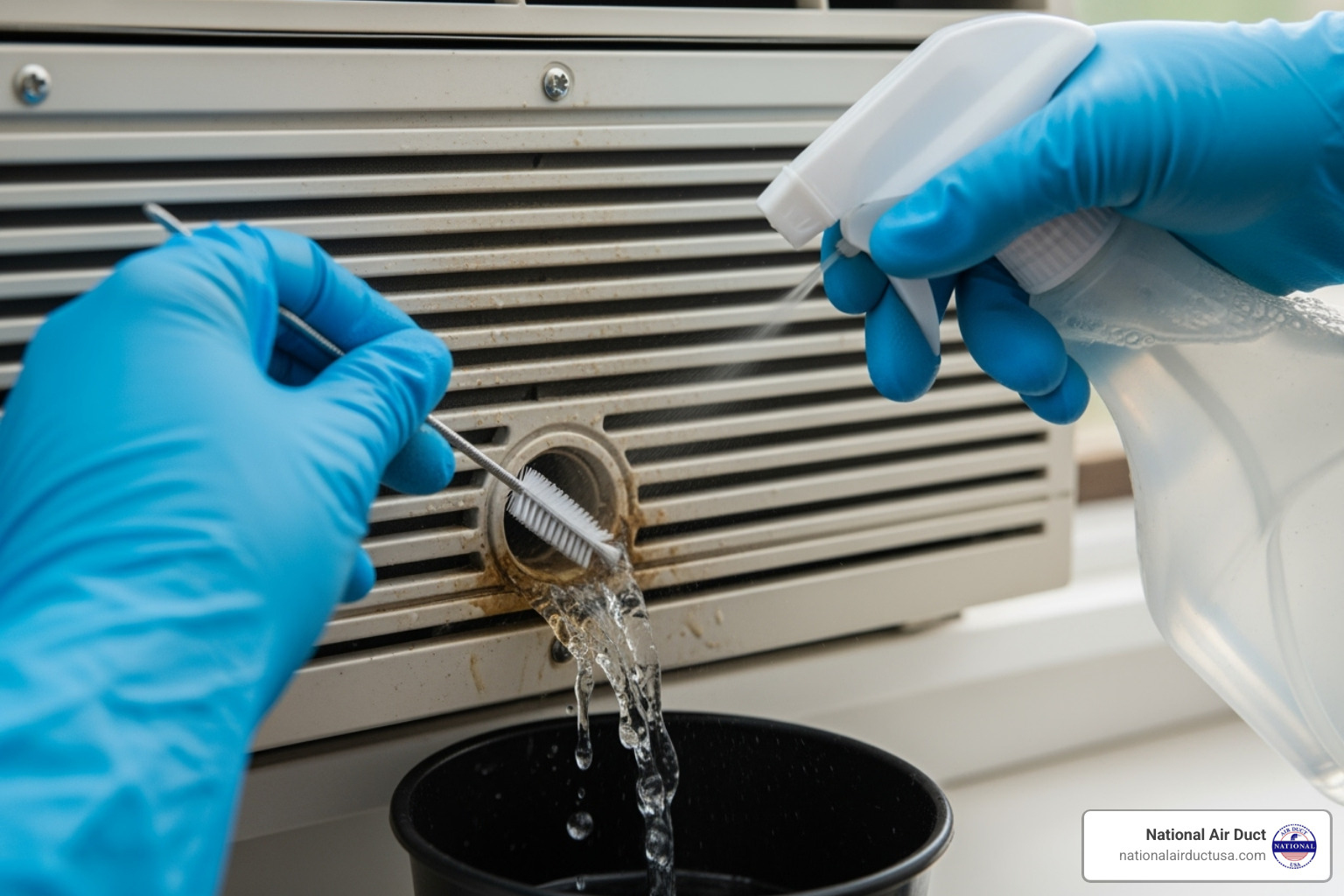
- Safety Gear: Safety gloves and goggles are essential.
- Clog-Clearing Tools: A bottle brush or a thin, flexible wire (like a straightened coat hanger).
- Cleaning Equipment: A wet/dry vacuum (rated for water), rags, a bucket, and a small funnel.
- Cleaning Solutions: Distilled white vinegar and mild soap with water.
- Other Tools: A screwdriver for any access panels.
Step-by-Step: How to Clean the Window AC Drain Line
Follow these steps to clean the drain line.
Step 1: Safety First! Turn Off and Unplug Your Unit
Always turn off your window AC unit and unplug it from the wall before starting. If you can’t reach the plug, flip the circuit breaker. Water and electricity are a dangerous mix. Wait a few minutes for any electrical charge to dissipate.
Step 2: Locate the Drain Hole
Most window air conditioners have the drain hole on the exterior underside of the unit. On older models, it’s often in the middle; newer units may have it on the side. If there’s a drainage hose, follow it to the drain pan. If not, look for drip marks. If the hole is hard to reach, you may need to remove the unit from the window. Call a professional if you’re not comfortable with this step.
Step 3: Understand Slinger Ring Models (No Drain Hole?)
If you can’t find a drain hole, you may have a slinger ring model. These units use a fan blade ring to sling water onto the hot condenser coils, which improves cooling efficiency. The drain hole may be intentionally plugged. Never drill your own drain hole, as you could damage the unit and cause a costly repair.
Step 4: Clearing Visible Debris
Once you locate the drain hole, use a bottle brush or thin wire to gently dislodge visible debris. Work the tool in and out of the hole to break up any blockages. Wipe away any dislodged gunk with a rag.
Step 5: The Flushing Method
Using a funnel, pour 1 cup of distilled white vinegar into the drain hole. Vinegar is safe for your system and effective at breaking down mold and algae. Let it sit for at least 30 minutes (a few hours is better) to dissolve the buildup. Afterward, flush the line with 2 cups of hot water, using a bucket to catch the runoff. If water flows freely, the clog is likely cleared.
Step 6: The Wet/Dry Vacuum Method (For Stubborn Clogs)
For stubborn clogs, use a wet/dry vacuum. Create a tight seal between the vacuum hose and the exterior drain opening using a rag or duct tape to maximize suction. Turn on the vacuum for a few minutes to pull the blockage out. You may need to repeat this a few times for severe clogs.
Step 7: Cleaning the Drain Pan
Clean the drain pan to prevent future clogs. Remove standing water and wipe the pan with mild soap and water. If removable, scrub it in a sink. Check for rust or cracks, which may indicate it needs replacement.
Step 8: Reassembly and Testing the Unit
Carefully reassemble any removed parts. Let the unit dry completely for a few hours before plugging it back in. Once dry, turn the AC on and check that water is dripping freely from the exterior drain (unless it’s a slinger ring model). This should resolve any overflow or musty smells.
Preventing Future Clogs and Ensuring Proper Drainage
Preventing clogs is the best way to avoid issues with your window AC. Regular maintenance is key, and a little effort goes a long way.
- Create a Regular Cleaning Schedule: Flush the drain line with vinegar every three months during peak season, or monthly in humid climates or homes with pets. This quick task prevents water damage and musty odors.
- Perform Annual Maintenance: Each spring, perform a thorough cleaning of the entire unit, including the coils and drain pan. Double-check the drain line, as even some professional service calls may overlook it.
- Ensure Proper Unit Tilt: The AC unit should have a slight downward tilt toward the outside (about a 2-4 degree angle, or half an inch). This allows gravity to help water drain properly and prevents pooling.
- Maintain the Air Filter: A dirty filter allows dust and debris to enter the drain pan, causing clogs. Clean or replace your filter every one to three months, depending on usage and home environment.
- Use an Off-Season Cover: When not in use, cover the exterior unit to protect it from debris and pests, preventing clogs when you use it next season.
By staying on top of regular maintenance, you’ll keep your window AC running efficiently. For more comprehensive insights into maintaining a healthy home environment, explore More info about clean ventilation systems.
When to Call a Professional for Help
While how to clean window ac drain line is often a DIY job, some situations require a professional HVAC technician.
- Persistent Clogs: If you’ve tried all the DIY methods and the line remains blocked, it’s time to call a pro. They have specialized tools like powerful air compressors and drain snakes to clear stubborn blockages.
- Electrical Issues: If you see frayed wires, smell burning, or suspect any electrical damage, unplug the unit immediately and call a professional. Do not attempt to fix electrical problems yourself.
- Complex Disassembly: If accessing the drain pan requires taking the unit apart in a complex way, it’s best to call a professional to avoid damaging components and causing a more expensive repair.
- Recurring Clogs: If the drain line clogs repeatedly despite regular cleaning, there may be an underlying issue like improper installation or excessive condensation. A professional can diagnose and fix the root cause.
The cost for professional drain line cleaning typically runs between $100-$150, depending on your location and the complexity of the job. This is often less expensive than repairing water damage or replacing the entire unit.
For comprehensive HVAC services and expert diagnosis of more complex issues, check out More info about HVAC Repair.
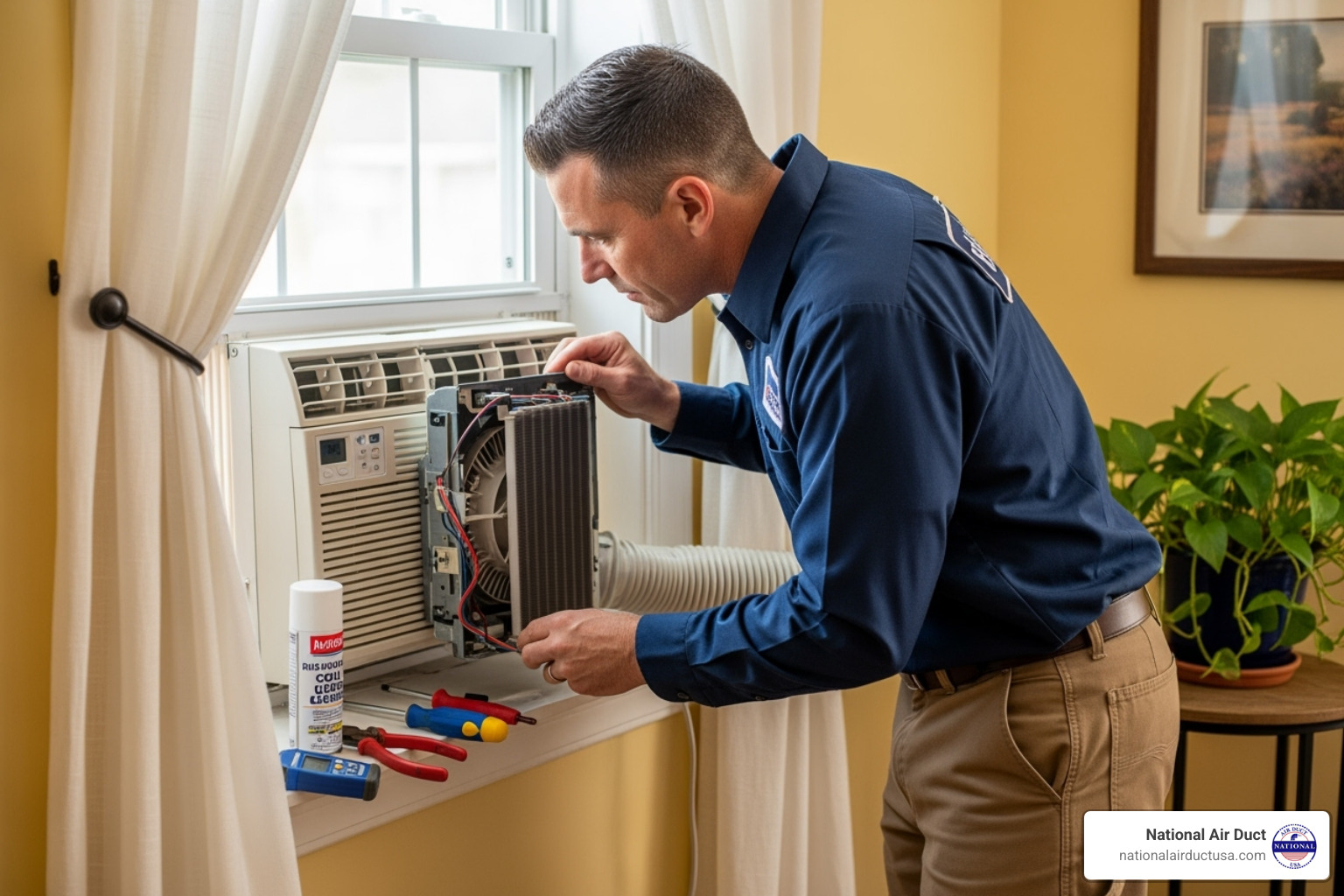
There’s no shame in calling for backup when you need it. Sometimes the most cost-effective solution is getting it done right the first time by someone who does this for a living!
Frequently Asked Questions about Cleaning Window AC Drain Lines
Here are answers to common questions about how to clean window ac drain line.
Can I use bleach to clean my AC drain line?
We strongly recommend using distilled white vinegar instead of bleach. While bleach kills germs, it has significant bleach risks. It is corrosive and can damage plastic drain lines and metal AC components over time. Most importantly, never mix bleach with other cleaners, especially vinegar, as this creates toxic chlorine gas. Vinegar as a safer alternative effectively kills mold and algae without damaging your unit or releasing harsh chemicals into your home.
My window AC doesn’t have a drain hole. What do I do?
This is normal for many modern units. They likely have a slinger ring function, where a ring on the fan blade flings collected water onto the hot condenser coils. This water recycling improves the unit’s efficiency. You only need to worry if the drain pan overflows and leaks into your home, which can happen in very high humidity or if the coil is dirty. Always check your manufacturer instructions to confirm your model’s design, and never drill your own drain hole.
How much does it cost to have a professional clean the drain line?
The cost range for a professional cleaning is typically $100-$150, but can be higher for complex jobs. In contrast, the DIY vs professional cost is minimal—just the price of vinegar and a brush. The professional price is affected by factors like the time and complexity of the clog, accessibility of the drain line, and whether it’s an emergency call. While DIY is cheaper, a professional fee can prevent much costlier water damage repairs. It’s best to try the DIY methods first, but call a professional if the problem persists or you’re uncomfortable with the task.
Keep Your Cool with a Clean AC
Successfully cleaning your window AC drain line is a satisfying task that protects your home and investment. By following the steps to spot warning signs and clear out gunk, you gain immediate and long-lasting benefits.
The importance of regular maintenance is clear. A clean drain line prevents water damage, stops mold from circulating in your air, and keeps your AC from working overtime, which saves on utility bills.
- Better air quality is a direct result. Without stagnant water and mold, the air in your home is fresher and healthier.
- Improved efficiency saves you money. A properly draining AC cools your space effectively without running constantly, lowering your energy costs.
You now have the knowledge to handle this task yourself, from a simple vinegar flush to knowing when it’s time to call in the professionals.
At National Air Duct USA, we see how proper maintenance transforms homes. While learning how to clean window AC drain line is a great start, your entire HVAC system works together to create your indoor environment.
For a comprehensive cleaning and inspection of your entire cooling system, consider a professional HVAC system disinfection. Our NADCA-certified experts understand New York’s unique climate challenges and can help ensure every component of your cooling system contributes to cleaner, healthier air in your home.
Stay cool, stay comfortable, and remember – a little preventive maintenance today saves you from big headaches tomorrow!

